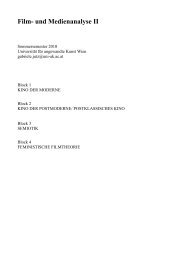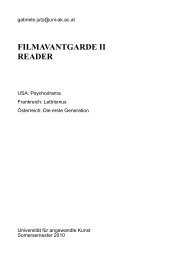Filmanalyse - Gabriele Jutz
Filmanalyse - Gabriele Jutz
Filmanalyse - Gabriele Jutz
Create successful ePaper yourself
Turn your PDF publications into a flip-book with our unique Google optimized e-Paper software.
104 Tom Gunning<br />
conditions » (which for me involves film as a commodity, primarily),<br />
nonetheless this concept allows us to grasp film genres as truly historical<br />
events. From this the conception of a historical series of film genres<br />
arises in which, to quote Hans Robert Jauss «the next work can solve<br />
formal and moral problems left behind by the last work, and present<br />
new problems in turn»/6.<br />
We can now turn to the limitation of the concept of genres in recent<br />
film analysis to aspects of content. Although there are reasons why this<br />
has been useful in the approach to later cinema (in which the concept of<br />
genre is basically one taken over from policy of production and distribution<br />
within the industry : hence the categories of musical, gangster<br />
film, horror film, etc.), it also has limited our approach to genre as an<br />
aspect of the actual form of films. The Russian Formalist come to our<br />
aid again in their (admittedly preliminary) works on film, with the<br />
concept of «cine-genres »/7. Writing in the 'twenties, the Formalists<br />
were primarily concerned to establish what genres were uniquely cinematic<br />
as opposed to those «parasitically » taken over from literature<br />
and drama. For our purposes, however, the most important aspect of<br />
the concept of cine-genres is that it does not define genres simply in<br />
terms of content (« Story » for the Formalists), but also in terms of its<br />
actualization as expression through the specific stylistic devices of film<br />
(« Plot » for the Formalists). As A. Piotrovskij puts it :« We shall define<br />
a cine-genre as a complex of compositional, stylistic, and narrative<br />
devices, connected with specific semantic material and emotional<br />
emphasis but residing totally within a specific 'native' art system —the<br />
system of cinema. Therefore, in order to establish the'cine-genres', it is<br />
necessary to draw specific conclusions from the basic stylistic laws of<br />
cine-art, the laws of 'photogeny' and 'montage'. We will observe how<br />
the use of 'space', 'time', 'people', and 'objects' varies from the point of<br />
view of montage and photogeny, depending on the genre. We will also<br />
observe how the narrative sequences are arranged, and what the interrelations<br />
among all these elements are within a given cine-genre »/8.<br />
This approach to genres is particularly useful in dealing with early<br />
cinema. This is partly because such «genres » as have already been<br />
discussed in early cinema — such as the chase film or the trick film —<br />
can partly be differentiated through their approaches to filmic space<br />
and time. Equally important is the way the genres of early cinema can<br />
16. Jauss, op. cit., p. 32.<br />
jl. Russian Formalist writings on the cinema are found in Russian Formalist Film<br />
Theory, ed. Herbert Eagle, Ann Arbor, 1981. On genre, see particularly Tynjanov<br />
(Tynyanov) «On the Foundation of Cinema », p. 100 and «Towards a Theory of<br />
Cine-Genres » by A. Piotrovskij, pp. 131-146. \ _<br />
/8. Piotrovskij, op. cit., pp. 131-132. t_vpt- 2e\ie"'n-2 Cl^ ):





![+ [R] - Gabriele Jutz](https://img.yumpu.com/7473913/1/190x245/-r-gabriele-jutz.jpg?quality=85)
![+ [R] - Gabriele Jutz - Sonance.net](https://img.yumpu.com/5987492/1/184x260/-r-gabriele-jutz-sonancenet.jpg?quality=85)